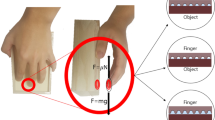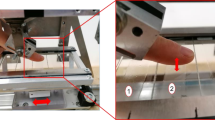Abstract
Human hands sweat in different circumstances and the presence of sweat can alter the friction between the hand and contacting surface. It is, therefore, important to understand how hand moisture varies between people, during different activities and the effect of this on friction. In this study, a survey of fingertip moisture was done. Friction tests were then carried out to investigate the effect of moisture. Moisture was added to the surface of the finger, the finger was soaked in water, and water was added to the counter-surface; the friction of the contact was then measured. It was found that the friction increased, up until a certain level of moisture and then decreased. The increase in friction has previously been explained by viscous shearing, water absorption and capillary adhesion. The results from the experiments enabled the mechanisms to be investigated analytically. This study found that water absorption is the principle mechanism responsible for the increase in friction, followed by capillary adhesion, although it was not conclusively proved that this contributes significantly. Both these mechanisms increase friction by increasing the area of contact and therefore adhesion. Viscous shearing in the liquid bridges has negligible effect. There are, however, many limitations in the modelling that need further exploration.










Similar content being viewed by others
References
Tomlinson, S.E., Lewis, R., Carré, M.J.: The effect of normal force and roughness on friction in human finger contact. Wear 267, 1311–1318 (2009)
Ramalho, A., Silva, C.L., Pais, A.A.C.C., Sousa, J.J.S.: In vivo friction study of human skin: influence of moisturizers on different anatomical sites. Wear 263, 1044–1049 (2007)
Derler, S., Gerhardt, L.-C., Lenz, A., Bertaux, E., Hadad, M.: Friction of human skin against smooth and rough glass as a function of the contact pressure. Tribol. Int. 42, 1565–1574 (2009)
Sivamani, R.K., Goodman, J., Gitis, N.V., Maibach, H.I.: Coefficient of friction: tribological studies in man—an overview. Skin Res. Technol. 9, 227–234 (2003)
Tomlinson, S., Lewis, R., Carré, M.J.: Review of the frictional properties of the finger-object contact when gripping. Proc. IMechE J. Eng. Tribol. 221, 841–850 (2007)
Mackenzie, C.L., Iberall, T.: The grasping hand. Skin: an organ critical for grasp. Adv. Physiol. 104, 205–218 (1994)
André, T., De Wan, M., Lefevre, P., Thonnard, J.-L.: Moisture evaluator: a direct measure of fingertip skin hydration during object manipulation. Skin Res. Technol. 14, 385–389 (2008)
André, T., Lefevre, P., Thonnard, J.-L.: A continuous measure of fingertip friction during precision grip. J. Neurosci. Methods 179, 224–229 (2009)
Nonomura, Y., Fujii, T., Arashi, Y., Miura, T., Maeno, T., Tashiro, K., Kamikawa, Y., Monchi, R.: Tactile impression and friction of water on human skin. Colloids Surf. B: Biointerfaces 69, 264–267 (2009)
Hendriks, C.P., Franklin, S.E.: Influence of surface roughness, material and climate conditions on the friction of human skin. Tribol. Lett. 37, 361–373 (2010)
Kwiatkowska, M., Franklin, S.E., Hendriks, C.P., Kwiatkowski, K.: Friction and deformation behaviour of human skin. Wear 267, 1264–1273 (2009)
Gerhardt, L.-C., Strassle, V., Lenz, A., Spencer, N.D., Derler, S.: Influence of epidermal hydration on the friction of human skin against textiles. J. R. Soc. Interface 5, 1317–1328 (2008)
Dinç, O.S., Ettles, C.M., Calabrese, S.J., Scarton, H.A.: Some parameters affecting tactile friction. J. Tribol. 113, 512–517 (1991)
Adams, M.J., Briscoe, B.J., Johnson, S.A.: Friction and lubrication of human skin. Tribol. Lett. 26, 239–253 (2007)
Persson, B.N.J.: Capillary adhesion between elastic solids with randomly rough surfaces. J. Phys. Condens. Matter 20, 1–11 (2008)
Deleau, F., Mazuyer, D., Koenen, A.: Sliding friction at elastomer/glass contact: Influence of the wetting conditions and instability analysis. Tribol. Int. 42, 149–159 (2009)
http://www.moritexusa.com/products/product.php?plid=5&pcid=10&pid=17. Accessed 1/12/09
Tomlinson, S.E., Lewis, R., Carre, M.J.: Understanding the effect of finger-ball friction on the handling performance of rugby balls. Sports Eng. 11, 109–118 (2009)
Adelman, S., Taylor, C.R., Heglund, N.C.: Sweating on paws and palms: what is its function? Am. J. Physiol. 229, 1400–1402 (1975)
Gajewski, A.: Contact angle and sessile drop diameter hysteresis on metal surfaces. Int. J. Heat Mass Transf. 51, 4628–4636 (2008)
Eroschenko, V.P., diFio, M.S.H.: DiFiore’s Atlas of Histology with Functional Correlations. Williams and Wilkins, Lippincott (2007)
Rosen, M.R.: Delivery System Handbook for Personal Care and Cosmetic Products—Technology, Applications and Formulations. William Andrew Publishing, Norwich, NY (2005)
Lévêque, J.-L.: Water-keratin interactions. In: Fluhr, J., Berardesca, E., Elsner, P., Maibach, H.I. (eds.) Bioengineering of the Skin: Water and the Stratum Corneum. CRC Press, Boca Raton, FL (2004)
Soneda, T., Nakano, K.: Investigation of vibrotactile sensation of human fingerpads by observation of contact zones. Tribol. Int. 43, 210–217 (2010)
Pailler-Mattei, C., Nicoli, S., Pirot, F., Vargiolu, R., Zahouani, H.: A new approach to describe skin surface physical properties in vivo. Colloids Surf. B: Biointerfaces 68, 200–206 (2009)
deVicente, J., Stokes, J.R., Spikes, H.A.: Rolling and sliding friction in compliant, lubricated contact. Proc. Inst. Mech. Eng. J. 220, 55–63 (2006)
Bongaerts, J.H.H., Fourtouni, K., Stokes, J.R.: Soft-tribology: Lubrication in a compliant PDMS-PDMS contact. Tribol. Int. 40, 1531–1542 (2007)
deVicente, J., Stokes, J.R., Spikes, H.A.: Behaviour of complex fluids between highly deformable surfaces: isoviscous elastohydrodynamic lubrication. Marie Curie Fellowship Association Annals, vol. IV (2005)
Johnson, S.A., Adams M.J., Arvanitaki, A., Briscoe, B.J.: Film thickness measurements in elastohydrodynamically-lubricated elastomeric contacts. Proceedings of the 23rd Leeds/Lyon Symposium on Tribology, pp. 199–207 (1997)
Agache, P.G., Monneur, C., Leveque, J.L., Rigal, J.D.: Mechanical properties and Young’s modulus of human skin in vivo. Dermatol. Res. 269, 221–232 (1980)
Incropera, F.P., De Witt, D.P.: Introduction to Heat Transfer, 2nd edn. John Wiley & sons, New York (1990)
Hamrock, B.J.: Fundamentals of Fluid Film Lubrication. New York (1994)
Tomlinson, S.T.: Understanding the friction between human fingers and contacting surfaces. PhD Thesis, The University of Sheffield, Department of Mechanical Engineering (2009)
Childs, T.H.C., Henson, B.: Human tactile perception of screen-printed surfaces: self-report and contact mechanics experiments. Proc. IMechE J: Eng Tribol. 217, 427–441 (2007)
DelRio, F.W., Dunn, M.L., deBoer, M.P.: Capillary adhesion model for contacting micromachined surfaces. Scripta Mater. 59, 916–920 (2008)
Park, A.C., Baddiel, C.B.: Rheology of stratum corneum-I: a molecular interpretaion of the stress-strain curve. J. Cosmet. Sci. 23, 3–12 (1972)
Park, A.C., Baddiel, C.B.: The effect of saturated salt solutions on the elastic properties of stratum corneum. J. Cosmet. Sci. 23, 471–479 (1972)
Dwyer-Joyce, R.S., Drinkwater, B.W., Donohoe, C.J.: The measurement of lubricant-film thickness using ultrasound. Proc. R. Soc. Lond. A 459, 957–976 (2003)
Ohlidal, I., Franta, D.: Ellipsometry of thin film systems. In: Wolf, E. (ed.) Progress in Optics, 41st edn, pp. 181–282. Elsevier, Amsterdam (2000)
Acknowledgments
We would like to thank B. Persson, Jülich Forschungszentrum for his advice about capillary adhesion.
Author information
Authors and Affiliations
Corresponding author
Rights and permissions
About this article
Cite this article
Tomlinson, S.E., Lewis, R., Liu, X. et al. Understanding the Friction Mechanisms Between the Human Finger and Flat Contacting Surfaces in Moist Conditions. Tribol Lett 41, 283–294 (2011). https://doi.org/10.1007/s11249-010-9709-y
Received:
Accepted:
Published:
Issue Date:
DOI: https://doi.org/10.1007/s11249-010-9709-y




